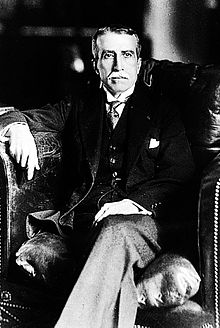Augusto B. Leguía y Salcedo
Augusto Bernardino Leguía y Salcedo (born February 19, 1863 in Lambayeque ; † February 7, 1932 in Lima ) was a Peruvian politician who held the presidency twice, from 1908 to 1912 and from 1919 to 1930.
Early years
Leguía y Salcedo was born in Lambayeque in 1863, the son of one of the leading families of the Peruvian oligarchy. After training in Valparaíso , Chile , he served in the Peruvian Army from 1879 to 1881 during the Saltpeter War .
After the war, he moved to the United States and held an executive position at the New York Insurance Company. At the beginning of the 20th century, Leguía had amassed great wealth and decided to return to Peru. There he entered the political stage in 1903 at the urging of Manuel Candamo , the then leader of the Partido Civil and Prime Minister José Pardo y Barreda . He took over the office of finance minister. When José Pardo rose to president in 1904, Leguía became the new prime minister. He remained in office until 1907 when he resigned to run for presidential elections the following year.
First term
In 1908, Leguía succeeded Pardo's new president (a sequence to be repeated in 1919) after winning the elections as a candidate for an alliance. Some of the first measures dealt with reforms of the social and economic system. This represented an attempt to industrialize Peru and transform it into a modern capitalist society.
On May 29, 1909, a group of citizens (supporters of the Democratic Party of Nicolás de Piérola ) managed to penetrate the government palace and demand Leguía's resignation there. Piérola's brother and sons were among the intruders. Since Leguía refused to resign, he was kidnapped by the group and taken in front of the Simon Bolivar Monument in Lima. There, too, he did not give in to the demands and the police had to use force to rescue the president; more than 100 people died in the fight.
Around the same time, Peru was embroiled in border disputes with five of its neighbors. Leguía managed to negotiate two of them, with Bolivia and Brazil .
- The border with Brazil was defined in the Treaty of Velarde-Río Branco. The new border mostly ran along two rivers (the Yaravi and Yaverija).
- The Polo-Bustamanta Agreement with Bolivia determined the division of Lake Titicaca . The border line to Tacna , which at that time was still under Chilean control, was also defined.
After Leguía's tenure ended in 1912, he was succeeded as president by Guillermo Billinghurst , a millionaire and businessman who had previously been mayor of Lima. In the years that followed, Leguía traveled frequently to Great Britain and the United States, where he learned about banking and finance methods that he would later apply in Peru. At this time there was also a dispute between Leguías and the Partido Civilista, which ultimately led to his resignation.
Second term
In 1919 Leguía sought again for the presidency. Fearing that the incumbent President José Pardo and parliament would not recognize his victory, Leguía launched a successful military coup . He dissolved the Congress ; the new parliament elected him constitutional president.
Leguía changed the Peruvian constitution and passed a new one in 1920, which was more liberal than the previous and more extensive civil rights (as well as an unlimited number of re-elections of the president). Although he enacted the new constitution himself, he largely ignored it and set up a dictatorial style government. The opposition was suppressed and many of its leaders were exiled. The most prominent of them was Víctor Raúl Haya de la Torre , who founded APRA in 1924 while in exile in Mexico . It became one of the most active and strongest parties in modern Peru.
Successful ventures during Leguía's second term included a modernization program for the capital, Lima. Infrastructural improvements financed by loans included improvements to health care through new hospitals and the construction of sewers. The government palace was also rebuilt, and new banks such as the Banco Central de Reserva del Perú and the Banco Hipotecario of Peru were built.
In addition, border treaties were signed with Colombia and Chile:
- The conflict with Colombia was resolved by splitting off the areas between the Putumayo and Caquetá rivers . This was officially regulated in the Treaty of Salomón-Lozano , which was only published after the fall of Leguías in 1930.
- The Tacna-Arica compromise was reached with Chile. However, this led to economic depression in the following years, for which Leguía was heavily criticized.
Fall
After 11 years in power and under the influence of the global economic crisis, which meant the end of capital inflows for Peru, Leguía was deposed in a coup on August 22, 1930 by Luis Miguel Sánchez Cerro . Leguía was arrested and charged with embezzlement. He remained in prison in Lima and died in hospital on February 6, 1932.
Web links
- Newspaper article about Augusto B. Leguía y Salcedo in the 20th century press kit of the ZBW - Leibniz Information Center for Economics .
| personal data | |
|---|---|
| SURNAME | Leguía y Salcedo, Augusto B. |
| ALTERNATIVE NAMES | Leguía y Salcedo, Augusto Bernardino (full name) |
| BRIEF DESCRIPTION | Peruvian President (1908–1912 and 1919–1930) |
| DATE OF BIRTH | February 19, 1863 |
| PLACE OF BIRTH | Lambayeque |
| DATE OF DEATH | February 7, 1932 |
| Place of death | Lima |
